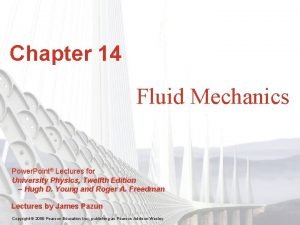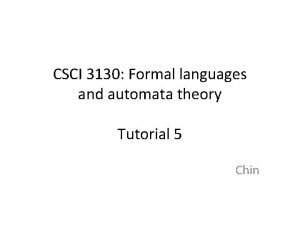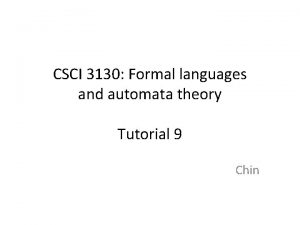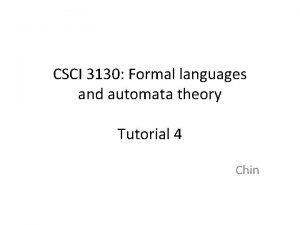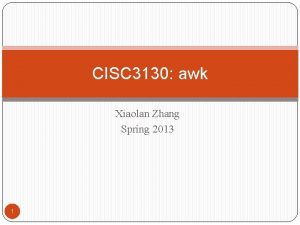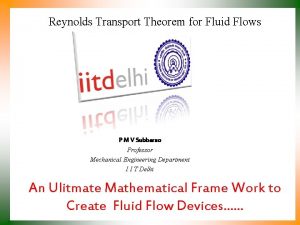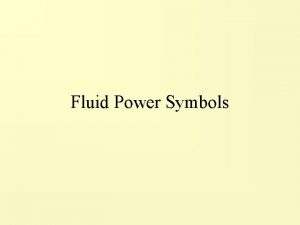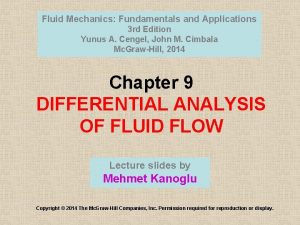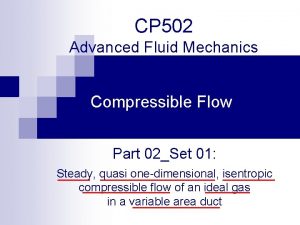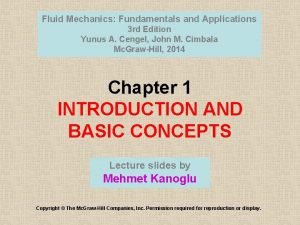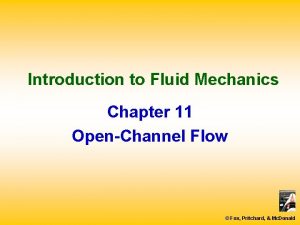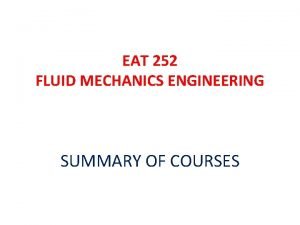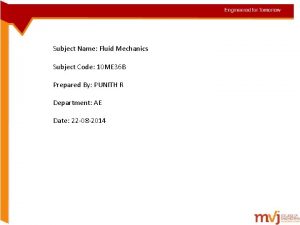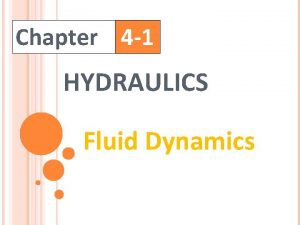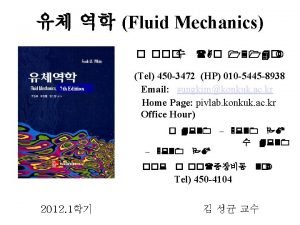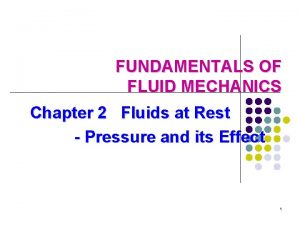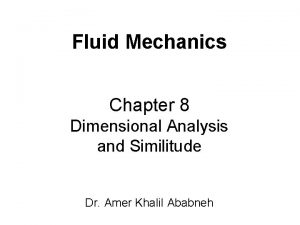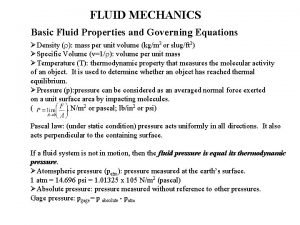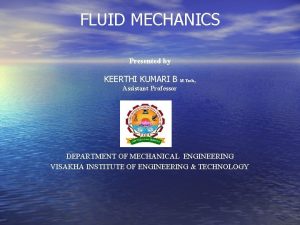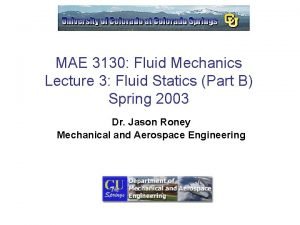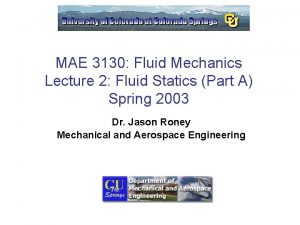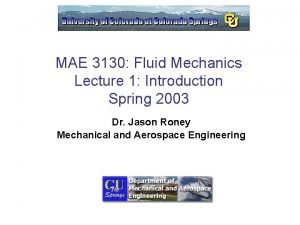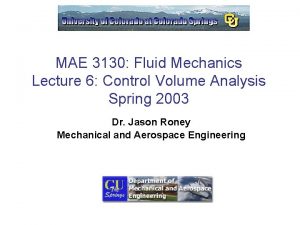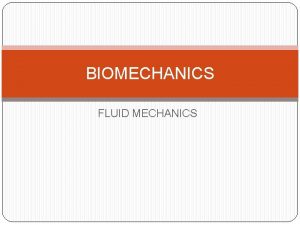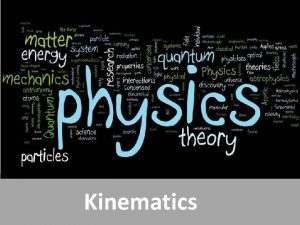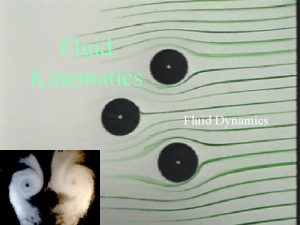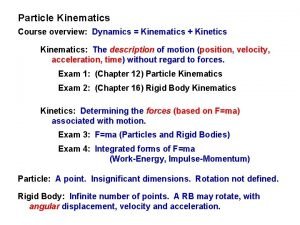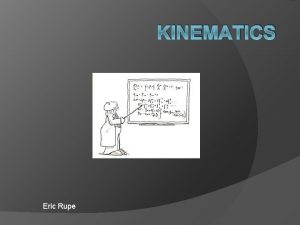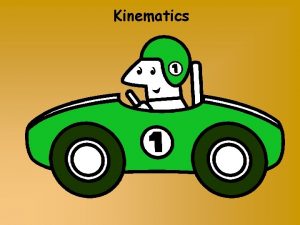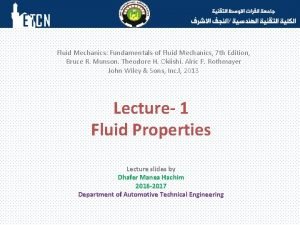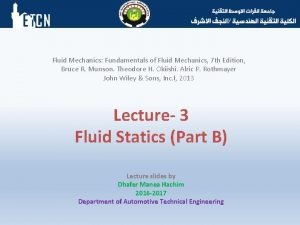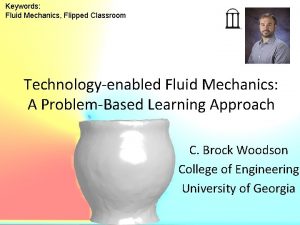MAE 3130 Fluid Mechanics Lecture 5 Fluid Kinematics






























- Slides: 30

MAE 3130: Fluid Mechanics Lecture 5: Fluid Kinematics Spring 2003 Dr. Jason Roney Mechanical and Aerospace Engineering

Outline • • Introduction Velocity Field Acceleration Field Control Volume and System Representation • Reynolds Transport Theorem • Examples

Fluid Kinematics: Introduction • Fluids subject to shear, flow • Fluids subject to pressure imbalance, flow • In kinematics we are not concerned with the force, but the motion. • Thus, we are interested in visualization. • We can learn a lot about flows from watching.

Velocity Field Continuum Hypothesis: the flow is made of tightly packed fluid particles that interact with each other. Each particle consists of numerous molecules, and we can describe velocity, acceleration, pressure, and density of these particles at a given time. Velocity Field:

Velocity Field: Eulerian and Lagrangian Eulerian: the fluid motion is given by completely describing the necessary properties as a function of space and time. We obtain information about the flow by noting what happens at fixed points. Lagrangian: following individual fluid particles as they move about and determining how the fluid properties of these particles change as a function of time. Measurement of Temperature If we have enough information, Eulerian Lagrangian we can obtain Eulerian from Lagrangian or vice versa. Eulerian methods are commonly used in fluid experiments or analysis—a probe placed in a flow. Lagrangian methods can also be used if we “tag” fluid particles in a flow.

Velocity Field: 1 D, 2 D, and 3 D Flows Most fluid flows are complex three dimensional, time-dependent phenomenon, however we can make simplifying assumptions allowing an easier analysis or understanding without sacrificing accuracy. In many cases we can treat the flow as 1 D or 2 D flow. Three-Dimensional Flow: All three velocity components are important and of equal magnitude. Flow past a wing is complex 3 D flow, and simplifying by eliminating any of the three velocities would lead to severe errors. 3 D Flow Field: Two-Dimensional Flow: In many situations one of the velocity components may be small relative to the other two, thus it is reasonable in this case to assume 2 D flow. One-Dimensional Flow: In some situations two of the velocity components may be small relative to the other one, thus it is reasonable in this case to assume 1 D flow. There are very few flows that are truly 1 D, but there a number where it is a reasonable approximation.

Velocity Field: Steady and Unsteady Flows Steady Flow: The velocity at a given point in space does not vary with time. Very often, we assume steady flow conditions for cases where there is only a slight time dependence, since the analysis is “easier” Unsteady Flow: The velocity at a given point in space does vary with time. Almost all flows have some unsteadiness. In addition, there are periodic flows, non-periodic flows, and completely random flows. Unsteady Flow: Examples: Nonperiodic flow: “water hammer” in water pipes. Periodic flow: “fuel injectors” creating a periodic swirling in the combustion Flow Visualize: chamber. Effect occurs time after time. Random flow: “Turbulent”, gusts of wind, splashing of water in the sink Steady or Unsteady only pertains to fixed measurements, i. e. exhaust temperature from a tail pipe is relatively constant “steady”; however, if we followed individual particles of exhaust they cool!

Velocity Field: Streamlines Streamline: the line that is everywhere tangent to the velocity field. If the flow is steady, nothing at a fixed point changes in time. In an unsteady flow the streamlines due change in time. Analytically, for 2 D flows, integrate the equations defining lines tangent to the velocity field: Experimentally, flow visualization with dyes can easily produce the streamlines for a steady flow, but for unsteady flows these types of experiments don’t necessarily provide information about the streamlines.

Velocity Field: Streaklines: a laboratory tool used to obtain instantaneous photographs of marked particles that all passed through a given flow field at some earlier time. Neutrally buoyant smoke, or dye is continuously injected into the flow at a given location to create the picture. If the flow is steady, the picture will look like streamlines (previous video). If the flow is unsteady, the picture will be of the instantaneous flow field, but will change from frame to frame, “streaklines”.

Velocity Field: Pathlines: line traced by a given particle as it flows from one point to another. This method is a Lagrangian technique in which a fluid particle is marked and then the flow field is produced by taking a time exposure photograph of its movement. If the flow is steady, the picture will look like streamlines (previous video). If the flow is unsteady, the picture will be of the instantaneous flow field, but will change from frame to frame, “pathlines”.

Acceleration Field Lagrangian Frame: Eulerian Frame: we describe the acceleration in terms of position and time without following an individual particle. This is analogous to describing the velocity field in terms of space and time. A fluid particle can accelerate due to a change in velocity in time (“unsteady”) or in space (moving to a place with a greater velocity).

Acceleration Field: Material (Substantial) Derivative time dependence spatial dependence We note: Then, substituting: The above is good for any fluid particle, so we drop “A”:

Acceleration Field: Material (Substantial) Derivative Writing out these terms in vector components: Fluid flows experience fairly large accelerations or decelerations, especially approaching stagnation points. x-direction: y-direction: z-direction: Writing these results in “short-hand”: where, ,

Acceleration Field: Material (Substantial) Derivative Applied to the Temperature Field in a Flow: The material derivative of any variable is the rate at which that variable changes with time for a given particle (as seen by one moving along with the fluid— Lagrangian description).

Acceleration Field: Unsteady Effects If the flow is unsteady, its paramater values at any location may change with time (velocity, temperature, density, etc. ) The local derivative represents the unsteady portion of the flow: If we are talking about velocity, then the above term is local acceleration. In steady flow, the above term goes to zero. If we are talking about temperature, and V = 0, we still have heat transfer because of the following term: 0 = 0 0

Acceleration Field: Unsteady Effects Consider flow in a constant diameter pipe, where the flow is assumed to be spatially uniform: 0 0 0

Acceleration Field: Convective Effects The portion of the material derivative represented by the spatial derivatives is termed the convective term or convective accleration: It represents the fact the flow property associated with a fluid particle may vary due to the motion of the particle from one point in space to another. Convective effects may exist whether the flow is steady or unsteady. Example 1: Example 2: Acceleration = Deceleration

Control Volume and System Representations Systems of Fluid: a specific identifiable quantity of matter that may consist of a relatively large amount of mass (the earth’s atmosphere) or a single fluid particle. They are always the same fluid particles which may interact with their surroundings. Example: following a system the fluid passing through a compressor We can apply the equations of motion to the fluid mass to describe their behavior, but in practice it is very difficult to follow a specific quantity of matter. Control Volume: is a volume or space through which the fluid may flow, usually associated with the geometry. When we are most interested in determining the forces put on a fan, airplane, or automobile by the air flow past the object rather than following the fluid as it flows along past the object. Identify the specific volume in space and analyze the fluid flow within, through, or around that volume.

Control Volume and System Representations Surface of the Pipe Surface of the Fluid Fixed Control Volume: Fixed or Moving Control Volume: Volume Around The Engine Inflow Outflow Deforming Control Volume: Outflow Deforming Volume

Reynolds Transport Theorem: Preliminary Concepts All the laws of governing the motion of a fluid are stated in their basic form in terms of a system approach, and not in terms of a control volume. The Reynolds Transport Theorem allows us to shift from the system approach to the control volume approach, and back. General Concepts: B represents any of the fluid properties, m represent the mass, and b represents the amount of the parameter per unit volume. Examples: Mass Kinetic Energy Momentum b=1 b = V 2/2 b = V (vector) B is termed an extensive property, and b is an intensive property. B is directly proportional to mass, and b is independent of mass.

Reynolds Transport Theorem: Preliminary Concepts For a System: The amount of an extensive property can be calculated by adding up the amount associated with each fluid particle. Now, the time rate of change of that system: Now, for control volume: For the control volume, we only integrate over the control volume, this is different integrating over the system, though there are instance when they could be the same.

Reynolds Transport Theorem: Derivation Consider a 1 D flow through a fixed control volume between (1) and (2): System at t 2 CV, and system at t 1 Writing equation in terms of the extensive parameter: Originally, At time 2: Divide by dt:

Reynolds Transport Theorem: Derivation Noting, (1) Let, (2) (3) (4) (1) Time rate of change of mass within the control volume: (2) The rate at which the extensive property flows out of the control surface: (4)

Reynolds Transport Theorem: Derivation The rate at which the extensive property flows into the control surface: (3) Now, collecting the terms: or Restrictions for the above Equation: 1) Fixed control volume 2) One inlet and one outlet 3) Uniform properties 4) Normal velocity to section (1) and (2)

Reynolds Transport Theorem: Derivation The Reynolds Transport Theorem can be derived for more general conditions. Result: This form is for a fixed non-deforming control volume.

Reynolds Transport Theorem: Physical Interpretation (1) (2) (3) (1) The time rate of change of the extensive parameter of a system, mass, momentum, energy. (2) The time rate of change of the extensive parameter within the control volume. (3) The net flow rate of the extensive parameter across the entire control surface. “outflow across the surface” “inflow across the surface” “no flow across the surface” Mass flow rate:

Reynolds Transport Theorem: Analogous to Material Derivative Unsteady Portion Steady Effects: Unsteady Effects (inflow = outflow): Convective Portion

Reynolds Transport Theorem: Moving Control Volume There are cases where it is convenient to have the control volume move. The most convenient is when the control volume moves with a constant velocity. Vo = 20 i ft/s, V 1 = 100 i ft/s , Then W = 80 i ft/s Now, in general for a constant velocity control volume:

Reynolds Transport Theorem: Choosing a Control Volume If we want to know a property at point 1, pressure or velocity for instance: Good choice, since the point we want to know is on control surface. Likewise, the values at the inlet and exit are normal to the surface. Valid control volume, but the point we want to know is interior. So, it unlikely we will have enough information to obtain its value. Valid control volume, but the surfaces are not normal to the inlet and outlet.

Some Example Problems
 Timeline in fluid mechanics
Timeline in fluid mechanics Aplusphysics kinematics-horizontal kinematics
Aplusphysics kinematics-horizontal kinematics Fluid kinematics ppt
Fluid kinematics ppt Ece 3130
Ece 3130 Formal languages and automata theory tutorial
Formal languages and automata theory tutorial Pushdown automata
Pushdown automata Ece 3130
Ece 3130 Automata theory tutorial
Automata theory tutorial Allcfg
Allcfg Ece 3130
Ece 3130 Csci 3130
Csci 3130 Heather lipford
Heather lipford Automata theory tutorial
Automata theory tutorial Cisc 3130
Cisc 3130 01:640:244 lecture notes - lecture 15: plat, idah, farad
01:640:244 lecture notes - lecture 15: plat, idah, farad Reynolds transport theorem fluid mechanics
Reynolds transport theorem fluid mechanics Unidirectional hydraulic pump symbol
Unidirectional hydraulic pump symbol Viscous fluid example
Viscous fluid example Cp fluid mechanics
Cp fluid mechanics Fluid mechanics fundamentals and applications
Fluid mechanics fundamentals and applications Specific force in open channel flow
Specific force in open channel flow Fluid mechanics summary
Fluid mechanics summary Fluid mechanics subject code
Fluid mechanics subject code Colligative properties calculator
Colligative properties calculator Hydraulic structures
Hydraulic structures Tel in fluid mechanics
Tel in fluid mechanics Fluid mechanics
Fluid mechanics Specific gravity define
Specific gravity define Similitude fluid mechanics
Similitude fluid mechanics Basic equation of fluid flow
Basic equation of fluid flow Fluid mechanics
Fluid mechanics


